paleomaxx
Hero Member
- Joined
- Aug 14, 2016
- Messages
- 841
- Reaction score
- 6,888
- Golden Thread
- 6
- Location
- Upstate, NY
- 🥇 Banner finds
- 6
- Detector(s) used
- Deus XP
- Primary Interest:
- All Treasure Hunting
I had two goals for this detecting year and this is one of them! I hiked to a new site on Sunday and literally the third hole I dug was this:
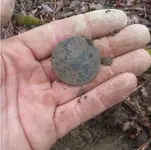
It was only four inches down in some nice clay soil which I think is why it's so well preserved. I hadn't even decided if the site had been hunted before, so to say I wasn't expecting this to turn up would be an understatement. And to top it off the shovel didn't come close to hitting it so no rueful scratches or dings to make me feel bad every time I look at it! After some extremely carefull cleaning here's how it came out:
After some extremely carefull cleaning here's how it came out:
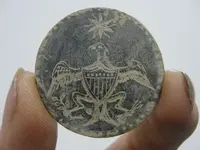
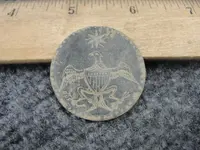
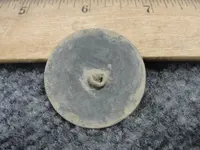
My technique was slow and gentle brushing with q-tips and I purposefully left dirt in the etchings so that I could keep the contrast and have the design really pop. It still has fantastic definition and I love the black patina. After safely stowing this I continued to grid the site and I am now certain in has never been detected before because the find density was incredible! Here are just the buttons:
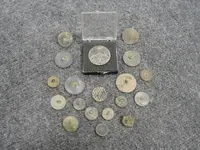
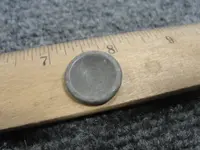
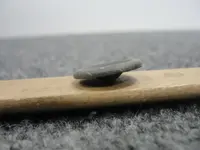
Most are medium or large tombac buttons (including the odd bowl-shaped one in the last photos), but there were a couple brass flat buttons too. Most of those had "London" backmarks so the distribution seems to be from the latter half of the 18th century to just the beginning of the 19th. I was actually surprised since I was expecting this to be a mid 19th century site.
There were a few coins including a 1787 Connecticut copper that would be the find of the day on any other hunt:
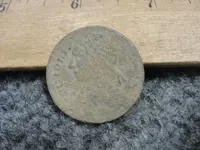
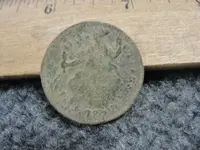
There's enough definition that I'm reasonably confident that it's a Miller 12-Q which is listed as scarce. I also found a toasted KG III and an 1829 large cent that's in okay shape.
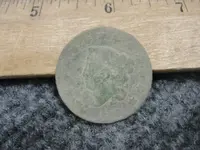
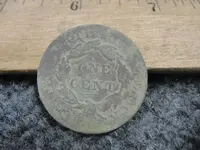
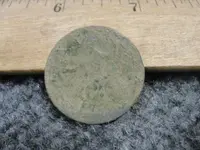
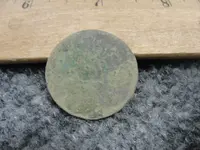
My other favorite find of the hunt was this beautiful, intact No 2 crotal bell.
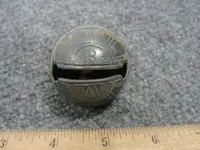
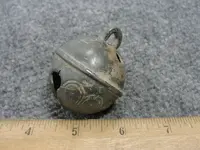
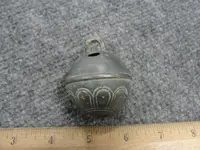
I find fragments all the time, but rarely intact specimens and this is only my third with the maker's mark. I didn't find any mention of "RW" in American bellmakers, but I did find one in the UK. Robert Wells from Aldbourne operated a foundry as did his son and grandson. The foundry was established in 1755 and operated for the three generations until bankruptcy in 1825. Since the "RW" mark likely didn't change during that time, it could be from anywhere in that range, but based on the site it's probably from the time of the son Robert Wells II so late 18th century.
There were quite a few bits and pieces, some of which I can identify, and a few mystery pieces:
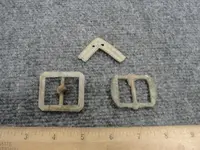
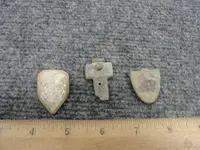
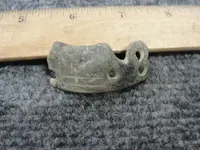
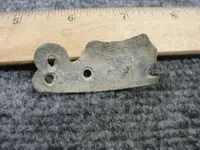
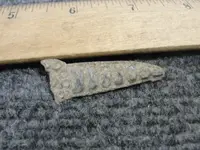
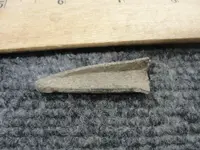
The pewter cone shaped piece is odd, but very decorative. There was surprisingly little large iron, but I've only just started to cover the ground at this site so I'm sure it'll turn up. I have my work cut out for me though as it's nestled in thick brambles. They're mostly flat now, but it's spring so the site is beginning to close up and in a few weeks I doubt I'll be able to swing anywhere near it. I can only imagine what's still in the ground there, but it'll be tough to top this hunt!
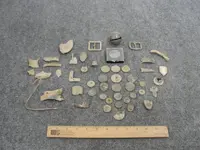

It was only four inches down in some nice clay soil which I think is why it's so well preserved. I hadn't even decided if the site had been hunted before, so to say I wasn't expecting this to turn up would be an understatement. And to top it off the shovel didn't come close to hitting it so no rueful scratches or dings to make me feel bad every time I look at it!
 After some extremely carefull cleaning here's how it came out:
After some extremely carefull cleaning here's how it came out:


My technique was slow and gentle brushing with q-tips and I purposefully left dirt in the etchings so that I could keep the contrast and have the design really pop. It still has fantastic definition and I love the black patina. After safely stowing this I continued to grid the site and I am now certain in has never been detected before because the find density was incredible! Here are just the buttons:



Most are medium or large tombac buttons (including the odd bowl-shaped one in the last photos), but there were a couple brass flat buttons too. Most of those had "London" backmarks so the distribution seems to be from the latter half of the 18th century to just the beginning of the 19th. I was actually surprised since I was expecting this to be a mid 19th century site.
There were a few coins including a 1787 Connecticut copper that would be the find of the day on any other hunt:


There's enough definition that I'm reasonably confident that it's a Miller 12-Q which is listed as scarce. I also found a toasted KG III and an 1829 large cent that's in okay shape.




My other favorite find of the hunt was this beautiful, intact No 2 crotal bell.



I find fragments all the time, but rarely intact specimens and this is only my third with the maker's mark. I didn't find any mention of "RW" in American bellmakers, but I did find one in the UK. Robert Wells from Aldbourne operated a foundry as did his son and grandson. The foundry was established in 1755 and operated for the three generations until bankruptcy in 1825. Since the "RW" mark likely didn't change during that time, it could be from anywhere in that range, but based on the site it's probably from the time of the son Robert Wells II so late 18th century.
There were quite a few bits and pieces, some of which I can identify, and a few mystery pieces:






The pewter cone shaped piece is odd, but very decorative. There was surprisingly little large iron, but I've only just started to cover the ground at this site so I'm sure it'll turn up. I have my work cut out for me though as it's nestled in thick brambles. They're mostly flat now, but it's spring so the site is beginning to close up and in a few weeks I doubt I'll be able to swing anywhere near it. I can only imagine what's still in the ground there, but it'll be tough to top this hunt!

Upvote
121




 and welcome to the Banner club.
and welcome to the Banner club.

